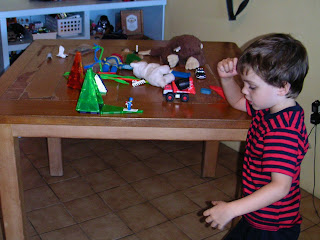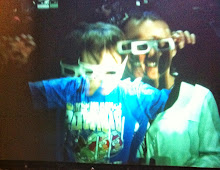Man, I am LOVING homeschooling a four-year-old! No offense to my son, who only recently graduated from the Tyrannical Threes (as I so affectionately called them), but I am so very thankful that his little self has now orbited the sun four entire times. Four definitely equals fun. There was a troubling time last summer when the strength of my desire to homeschool my son began to ebb. Day after day after day of pouring rice and stringing beads and dusting surfaces had dulled my enthusiasm. I knew the practical life activities my son was practicing were providing him with a strong sense of self-sufficiency (as well as introducing him to the structure and routine of our homeschool). I knew also that preschoolers crave repetition; that they acquire new skills by performing routine tasks ad nauseum. I knew all this and still I could not help feeling mind-numbingly bored during our homeschool sessions. Well, it's a new dawn, it's a new day and I'm feeling good. All of a sudden (sort of), my son is no longer a short-attention-span-possessing, emotionally-unstable, instant-gratification-seeking toddler. All of sudden (sort of), he is a little boy, curious about the world, passionate about animals and space (and also vehicles, of course), willing to concentrate, able to stay calm (mostly), capable of discussing various cool and awe-inspiring topics with me. Seriously: new dawn, new day.
So we've been having an absolute ball in our homeschool (and outside of it as well). We've been learning about animals--having these great, fun talks about myriad species (a lot of said talks edifying not only to my son but also to me). We've been spelling words using the movable alphabet. We've been having fun with geometry with the Magna-Tiles I wrote about in my last post. And we've been discussing space a lot. Parker is fascinated by space right now. He loves learning about the planets; he loves creating rockets and flying them to the moon; he's half-terrified, half-enthralled by the fact that meteors exist. It warms my heart, seeing my son so in love with learning. All I want to do is foster that love, to nurture it and help it grow. In light of that, I recently visited the National Geographic Store's website, expecting to only browse around, possibly purchase one or two educational books about the solar system or animals. (Brief aside: I read a while back that boys--even little boys--usually prefer to read nonfiction; that storybooks don't do it for them as much as informative, fact-packed texts. At the time, I thought to myself, "Yeah, right. Why do people insist on stereotyping our children based on so-called gender-based characteristics?" About a nanosecond after I thought that, Parker started pulling out only his nonfiction books at story time, and continues to do so. I, being female, would love to read scads of magical storybooks with my child; Parker prefers his Usborne flap books.) Anyway, it's a good thing I can comfort myself with the nonprofit mission of the National Geographic Society, because I spent a chunk of change buying books from their online store. There were just so many cool kids' books! (And I could seriously use a break from reading Parker's flap books.) Our new books arrived last week, and we've been reading Moon from the "Jump into Science" series repeatedly. It's a neat little book, with cute illustrations and fun facts about the moon. The author clearly explains why the moon goes through phases, why it looks like it's the same size as the sun (but is really not), that the moon orbits the earth, how the craters on the moon are created and that the moon reflects the sun's light (rather than creating light of its own).
I really like National Geographic Kids' "Jump into Science" series; each book has a "bonus" experiment at the end. Moon's experiment is "Making Craters." You pour about an inch of flour into a cake pan, then find five rocks of various sizes. After explaining to your child that the flour is the moon and the rocks are meteors, you have the child drop the rocks into the flour from about two feet above the pan. (Parker REALLY liked exclaiming, "Here comes a meteor!" every time he dropped a rock.) Then you talk about what happened; how the flour flew out of the way when a rock hit it, creating a crater; how big rocks made big craters and little rocks made little craters. In the book, the author explains that the earth's air protects us from most meteors by causing them to burn up, so I made sure to remind Parker of that fact while he was making meteors crash onto the "airless" moon. Of course, Parker wanted to repeat this experiment over and over and over, which was fine. It wasn't super fun cleaning up the spilled "moon dust," but I'm fine sacrificing a little elbow grease for the sake of science.
Postscript: The next day in school, we did another moon experiment. We brought a small mirror and a flashlight into "outer space" (the darkest room in the house, Parker's bedroom). I held the mirror while standing about five feet from Parker, with the flashlight propped on a table in a corner of the room. First, with the flashlight turned off, I asked Parker if he could see the "moon" (aka the mirror). The I turned on the flashlight, pointed it away from the mirror and again asked Parker if he could see the moon. Then I moved the mirror so that the flashlight shone on it and the light reflected onto Parker. He said, "I see it! And it's bright!" I explained that the flashlight was the sun, the mirror was the moon and he was the earth. Fun stuff.
 |
| First of many craters. |
 |
| "Here comes a meteor!" |
 |
| Collecting moon dust and meteors. |
 |
| Sifting the moon dust from the meteors so that he could repeat the experiment. |





